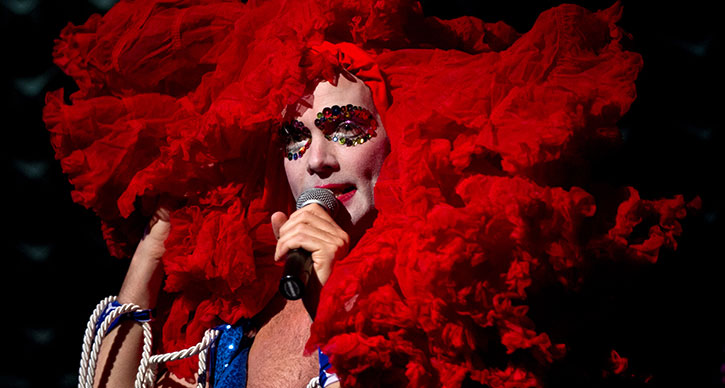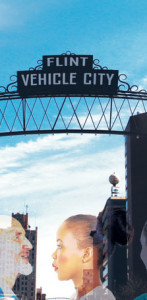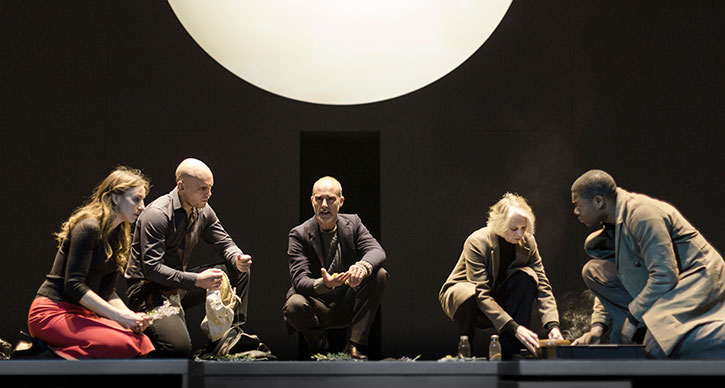Artist in Residence Update: Being Weird in Flint
Editor’s note: Andrew Morton is a theater maker and one of our 2015-2016 artists in residence. As part of this program, artists in residence attend UMS performances to inspire new thinking and creative work within their own art forms. Andrew saw Taylor Mac’s performance. Below is his response to the show and to an artist-led workshop with his students at Flint Youth Theatre.

Flint Youth Theatre students with their creations, also with Andrew Morton and Machine Dazzle. Photo by Annick Odom.
While Taylor Mac’s A 24-Decade History of Popular Music was in Ann Arbor earlier this month, Machine Dazzle (Taylor Mac’s Costume Designer) came to do a workshop with some of my students at the Flint Youth Theatre. In preparation for the workshop with Machine, the students and I watched a couple of videos of excerpts from the 24-Decade project. During one of the videos, I was struck by what Taylor said about his interest in “imperfection fostering community.” Since the workshop with Machine and after seeing Act VII of the 24-Decade project a few weeks ago, I’ve been thinking a lot about this idea of imperfection.
When I first heard these words, naturally I immediately connected them to what is still happening in Flint with the ongoing saga of our water crisis.
Yes, we have some severe challenges ahead of us, but once again the resilience of this incredibly “imperfect” community continues to inspire me.
When Machine and some of the UMS team came to Flint to work with my students, it was just a couple of days after Snoop Dogg was handing out water in my friend’s neighborhood. The day before the workshop, I had a call from a friend who had just received a call from Macklemore’s people. They were looking for a space as he was also coming to Flint and wanted to meet with some young people. Now I hear Beyoncé is raising money for Flint during her next tour. That’s great. We need money, and a lot of it. But that’s not all we need.
Machine didn’t hand out water (or money) to the kids in my class, and we didn’t really talk about how the water crisis is affecting them. It is, and we already do talk about it, a lot. Instead, we made beautifully weird and wonderful costume pieces together. We talked about what inspired us to create, and how we can use our personal stories and experiences to create a piece of art.
Being weird
One of the things I love most about working at a place like Flint Youth Theatre is that it’s one of those places that attract the weird kids, the kids who probably have a horrible time at school and feel like they don’t have many places where they can truly be themselves. At our theatre, being weird is not something to be ashamed of. It’s something to be embraced. For the two hours Machine worked with us, we were reminded of how great it is to be weird, and how it’s even better when you have a community of people to be weird with, and to create with.
Later that week I attended Taylor Mac’s performance of A 24-Decade History of Popular Music: 1956-1986. I was already familiar with judy’s work (judy is Taylor’s preferred gender pronoun), but this was the first time I was able to see judy perform live, and I certainly hope it won’t be the last.

Taylor Mac performs. Photo courtesy of the artist.
I had been looking forward to this performance since late last year when I saw a production of judy’s play Hir at Playwrights Horizon in New York, arguably one of the best productions I saw in 2015. While very much a traditional play in its structure and form, it was unlike anything I had seen in a long time. The play celebrated the shift that is happening (albeit it very slowly) as we move away from the old world order (straight, conservative, hetero-normative) to a new one that is increasingly queer, progressive, and gender-fluid. Hir was about “smashing the patriarchy” and celebrating the formation of new communities based on shared ideas and experiences, and in many ways the 24-Decade project is doing the same thing. While I experienced Hir much like we experience the majority of western theater (as a mostly passive audience member sitting in the dark) the 24-Decade performance created an entirely different experience for its audience.
At the start of the evening, judy made it pretty clear that it was no surprise that a large portion of the audience was made up of people presumed to be mostly wealthy, privileged “Ann-Arbor types.” Judy even made some of those types stand up and move to either side of the theater, in an attempt to demonstrate the concept of white-flight. In a welcome act of solidarity with the community of Flint, judy also made a point to mention the water crisis and encouraged people to tweet or email our “tough nerd” governor about it. Naturally I did this with glee, and was pleased to see the reaction of many in the audience echoed mine.
Smashing patriarchy
Despite notable differences in the audience (the queers and the straights, the Flint or Detroit types and the Ann Arbor types, the rich and the not-so rich), community was formed during the shared experience that Taylor curated over those three fabulous hours. There was laughter, joy, probably a lot of confusion, and perhaps embarrassment on the part of some members of the audience who were roped into participating. I however was more than willing to help carry out a fellow audience member who represented a dead Judy Garland as Taylor sang Goodbye Yellow Brick Road.
I’m impressed by the ambitious nature of the 24 Decade project, and how judy is using performance and storytelling to build a new community, and to “smash the patriarchy” in American theater and in our culture at large.
This experience was a welcome reminder of how important it is to encourage weirdness, embrace imperfection, and help create community, and I’m thankful I get to do all of these things in a wonderfully weird and imperfect place like Flint.
Interested in more? Follow the adventures and process of other UMS Artists in Residence.
Watching Antigone: The Most [Blank] City in America
Editor’s note: Andrew Morton is a theater maker and one of our 2015-2016 artists in residence. As part of this program, artists in residence attend UMS performances to inspire new thinking and creative work within their own art forms. Andrew saw Antigone, starring stage and screen actress Juliette Binoche and in new translation by award-winning author Anne Carson. Below is his response to the performance.
When I learned I was accepted to the UMS Artist in Residence program earlier this year, I was on a farm in Grinnell, Iowa, working on a new project about Flint, Michigan. I was in the middle of another residency program with Grin City, an arts collective and residency program with a focus on social practice, and I was working on an early draft of an outline for The Most [Blank] City in America, a community-based play I am developing for Flint Youth Theatre’s 15-16 season.
Flint, Michigan

Artwork for performances.
The project was born from conversations with colleagues at Flint Youth Theatre and members of the Flint community about creating a performance that would explore what it means to call a place like Flint, Michigan “home.” It also came from a collective desire to create something that might challenge the dominant narrative of Flint.
If you ask people to share a word to describe Flint, quite often the response is something along the lines of:
- “Violent”
- “Dangerous”
- “Miserable”
- And so on…
Far too many times the City of Flint has been, and still is the subject of sensationalist articles that focus purely on the violence, poverty, and economic woes that continue to plague the city. Most recently the city and state’s disastrous handling of the water crisis has meant that once again, Flint is in the headlines for all the wrong reasons.
The people of Flint know the city has its fair share of problems, but they also know that is only part of the story of this place. As part of the research for the Most [Blank] City… project, we’ve had conversations with community members in schools, churches, community centers and parks, and we’ve asked people to tell us what other words they would use to describe their city. We’ve heard words and phrases like:
- “Misunderstood”
- “Tenacious”
- “Secretly Vibrant” (one of my personal favorites)
- And many more.
With a team of local artists, I’ve been having these conversations for the last few months. In April 2016, Flint Youth Theatre will produce the performance inspired by these important conversations. A collaboration with two incredible Flint-based arts organizations (Raise it Up! Youth Arts & Awareness and Tapology), the performance will incorporate drama, dance, spoken-word, music, and hopefully more. As we begin to develop an idea of what this performance will look and sound like, we’re realizing that while we want this project to tell a different story of Flint, we must also accept that our community can’t ignore our problems. If we want to change these problems, we need to face them head-on.
Antigone, listening

I saw Ivo van Hove’s production of Antigone in October, and the play inspired me greatly as I continue to work on the project in Flint. Going into the performance, I was most interested to see how the Chorus would be represented, as I’m considering the idea of including a “Flint Chorus” in The Most [Blank] City… as a way to represent the people of Flint from both the past and present. Watching Antigone, I found myself drawn to the Chorus as they watched from afar, listened intently, and served as a voice for the people of Thebes. They empathized with the characters, but were also quick to criticize, show their despair, and change their views as the events of the story unfolded before them.
I’d like The Most [Blank] City… to be a conversation about the story of Flint’s past and the unwritten story of its future, and I hope our audiences (those who are from Flint and those who are not) will be able to see themselves as a necessary part of this conversation.
As part of the ongoing research for this project, last week I led several story circles (a common practice in community-based theater) with young people in Flint. One took place at a High School just outside of the city, another was with students in a dual-enrollment program at U-M Flint, and the other was with members of the student ambassador group at Flint Youth Theatre. While it’s my job to ultimately construct the shape and content of this performance, for this piece to be an honest reflection of the diverse voices of Flint, I believe that my main role in this project is to simply listen. Listening to the young people I met with last week, I heard their anger at the injustices in Flint. I heard their descriptions of how local and state elected official have failed them. I heard, for many, a strong desire to leave this community as soon as they can. I heard mourning for the lives they’ve lost. However, I also heard, despite it all, that many of them are still immensely proud to call this place their home and are hopeful about its future.
An honest story

There’s little to be hopeful about in Greek Tragedy. People often ask me why I stay in Flint, as often the perception is there’s also little to be hopeful about here. In Antigone, the city of Thebes is in crisis, as Flint is today. As Kreon attempts to bring order and structure to the city, Antigone is in mourning and she is angry. Much like the young people in Flint. Her anger fuels her to take action and challenge Kreon’s authority. Many of the young people I meet in Flint have a strong sense of justice and want to see their community thrive. They want to be part of the conversations about the future of their city but are often left out. They want to take action, but often feel that no one will listen.
We’re trying to do many things with The Most [Blank] City in America project. I don’t expect the performance to incite a political revolution in Flint, but I do hope it inspires some change. I hope it will tell an honest story of this place, one that celebrates the hidden beauty of the city but also asks the difficult questions about why we continue to struggle. At the very least, I hope it will provide a space for the elders and the leaders of this community to hear the anger, the passion, and the hope of the young people who still call this place their home.
Photos of Antigone are courtesy of the artist.


